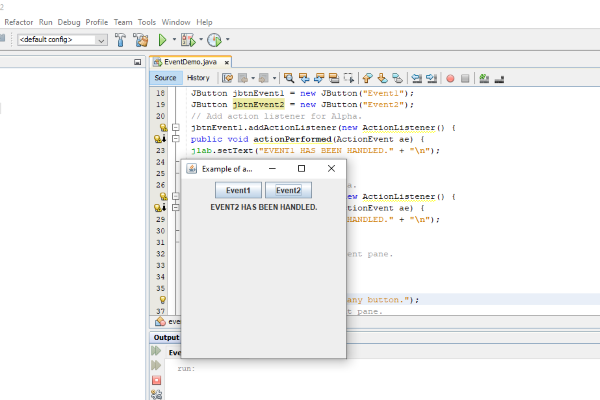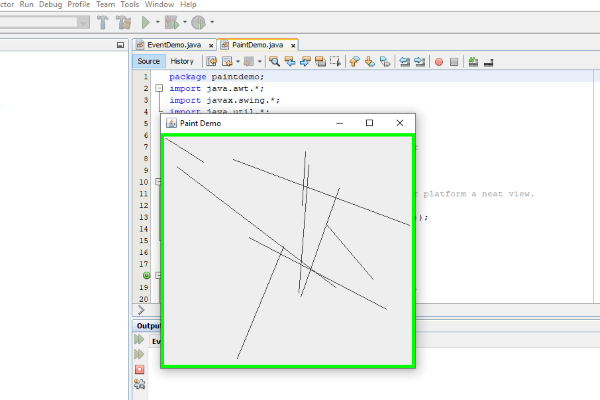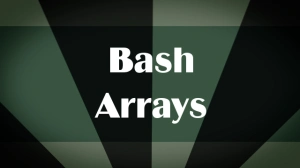Java Foundation Class took Swing Framework to be part of it. Java version 1.1 initially contained Swing as a well-defined library. Later on, it got integrated into the Java language.
The framework can enhance issues due to the fact that frameworks may be large and complex. When we recall small programs, a spring framework can bring about more incredible difficulty than the unique gadget it supposedly improves. Swing has dreams that lessen any harsh results that a larger framework ought to do.
The primary objective of the framework is to provide the kernel of a Swing application, assisting programmers in getting started swiftly and gaining optimum practices from just a few elements similar to every Swing Framework.
Prerequisites
To follow along with this article, the reader must have the following:
- Familiarity with Java programming language.
- Familiarity java swing. Refer to this introduction to java swing article.
Pluggable feel and look provided by swing
The pluggable feel and look provided by Swing is one of the reasons that makes it considered by Java code. The control of Swing makes it create an aesthetic feeling. Meaning that Swing can separate the look and feel of a component from the component’s logic.
It is possible to “plugin” a new look and feel for any given component without creating any side effects in the code that uses that component. Pluggable feel-and-look has significant benefits all through.
It is recommended to have a feel and look that is uniform across all platforms. Suppose an application will be running in a MacOS environment only, it is reasonable to define the MacOS feel and look. It is also possible to model the convention feel and look.
To sum up, the feel and look can be changed dynamically at run time.
The MVC (Model-View-Controller) connection
The Swing framework is ideal since it is underpinned by the ideas and design referring to the link created by the MVC. Problems arise from Swing components due to a high level of differences caused by the separation of the controller and view.
On the other hand, Swing deploys a modified version of MVC that combines view and controller binding into an exclusive, logical object referred to as the UI delegate. The Separable Model blueprint or the Model-Delegate blueprint are the two techniques used by Swing.
Although the component blueprint of swing’s Framework is based on MVC, the traditional implementation is not deployed. The blueprint of the Model-Delegate resizes and realizes swing’s pluggable feel and look.
Event handling
Since we have some information about swing frameworks, we can discuss how events are handled in this section. Swing generates the interactions to be governed by the components responding to user input as well as events. When a set timer goes off, it triggers an event.
The most important part of all swing-based applications is event handling. In most instances, Events in AWT are also used in swings, and the execution of these events are all contained in java.awt.event. The java.swing.eventallows for packaging only swing-specific events.
Illustrated by the code below is an event-generated swing button PUSH .
package eventdemo;
import java.awt.event.*;
import javax.swing.*;
class EventDemo {
JLabel lbJ;
EventDemo() {
JFrame frJ = new JFrame("EVENT HANDLER ILLUSTRATOR");
// We will be performing layout specification
frJ.setLayout(new FlowLayout());
// At this point we have to assign our frame a primary size.
frJ.setSize(400, 400);
// When the user closes the application, the program should stop.
frJ.setDefaultCloseOperation(JFrame.EXIT_ON_CLOSE);
// You can create as many buttons but here we are going create only two.
JButton jbtnEvent1 = new JButton("Event1");
JButton jbtnEvent2 = new JButton("Event2");
// Implementing Event1 listener.
jbtnEvent1.addActionListener(new ActionListener() {
// Declaring ActionPerformed to be visible to all classes.
public void actionPerformed(ActionEvent ae) {
lbJ.setText("EVENT1 HAS BEEN HANDLED." + "\n");
}
});
// include listener for Event2.
jbtnEvent2.addActionListener(new ActionListener(){
lbJ.setText("EVENT2 HAS BEEN HANDLED." + "\n");
}
);
frJ.add(jbtnEvent1);
frJ.add(jbtnEvent2);
// text-based label will have to be created.
lbJ = new JLabel("Press any button.");
// Putting labels.
frJ.add(lbJ);
//Putting the frame on display.
frJ.setVisible(true);
}
// Declaration of the main method
public static void main(String args[]) {
//This metod uses Swing for its user interface.
SwingUtilities.invokeLater(new Runnable() //declaration of utility methods.
{
public void run() {
//Recall method (function) EventDemo
new EventDemo();
}
});
}
}
When you run your program, the first output will be as shown below:

When you click the first button, you get the display shown below:

When you click the second button, you get the output display shown below:

Performing swing painting
For the painting to be achieved, we need to understand the following. Swing Framework is robust as it happens that it does not limit to using Swing Framework since it has functions allowing users to input directly into the output area of the frame, panel, or other components of Swing, such as JLabel.
Moreover, in several cases, the usage of Swing will not need a direct drawing to the display of the component. This functionality is dependant on those applications.
To input directly in the given output of the presentation included in a component, you will be required to use the drawing approaches and procedures in the AWT library, like the drawRect() method, or even the drawLine() method.
// We will painting the panel lines.
package paintdemo;
import java.awt.*;
// Allows for use of input methods on swing at runtime
import javax.swing.*;
// allows for importing of java class or packages
import java.util.*;
// In the panel lines are plotted.
class PaintPanel extends JPanel {
Insets set; // The panel holder is Insets
Random rand; // Generation of random numbers
// Construction of the panel.
PaintPanel() {
//Placing a border around the panel gives yuor platform a neat view.
setBorder(
//Defining the border shade
BorderFactory.createLineBorder(Color.GREEN, 5));
//An object for random outputs is created.
rand = new Random();
}
// PaintComponent() function needs to be overriden.
@Override
protected void paintComponent(Graphics j) {
// Superclass method calling first has to be done.
super.paintComponent(j);
// Declaring of variables
int a, b, a2, b2;
// We are getting the dimensions.
int hgt = getHeight();
// Declaring Method for getting height and width.
int wdt = getWidth();
// Getting the insets.
ins = getInsets();
// Randomly produced endpoints of nine lines are drawn.
for(int i=0; i < 9; i++) {
// At this point we will be acquiring random coordinates.
a = rand.nextInt(wdt-ins.left);
b = rand.nextInt(hgt-ins.bottom);
a2 = rand.nextInt(wdt-ins.left);
b2 = rand.nextInt(hgt-ins.bottom);
// Drawing of the lines.
j.drawLine(a, b, a2, b2);
}
}
}
// Description of painting onto the plane.
public class PaintDemo {
// Creation of an object for JLabel.
JLabel lbJ;
// Creation of class PaintPanel.
PaintPanel jj;
PaintDemo() {
// JFrame repository is created.
JFrame frJ = new JFrame("Paint Demo");
// Defining the area to be displayed at execution.
frJ.setSize(400, 400);
// End the program on closing of the swing application.
frJ.setDefaultCloseOperation(JFrame.EXIT_ON_CLOSE);
// Creation of the panel that will need painting.
jj = new PaintPanel();
frJ.add(jj);
// Showing the display .
frJ.setVisible(true);
}
// Declaring the main method.
public static void main(String args[]) {
// Thread event execution are created in relation to the frame.
SwingUtilities.invokeLater(() -> {
PaintDemo paintDemo = new PaintDemo();
});
}
}

The paintComponent() method is overridden by the PaintPanel, to manage painting. It also enables the PaintPanel to write directly onto the output display of the component while painting is being carried out.
The program has a default border format, making the area not to be declared, and adding the panel towards the middle. The display in the panel is sized to fill the middle.
Conclusion
In this article, we have learned how to perform the following task using swing frameworks:
- Handling events.
- Painting in the panel.
- Understanding how swing supports a pluggable look and feel.
- Understanding the concept of MVC.
Moreover, you are also equipped with the necessary information to handle swing frameworks entirely. You are now a swing geek.
Enjoy designing of Swing frameworks!
Happy coding!










Comments: